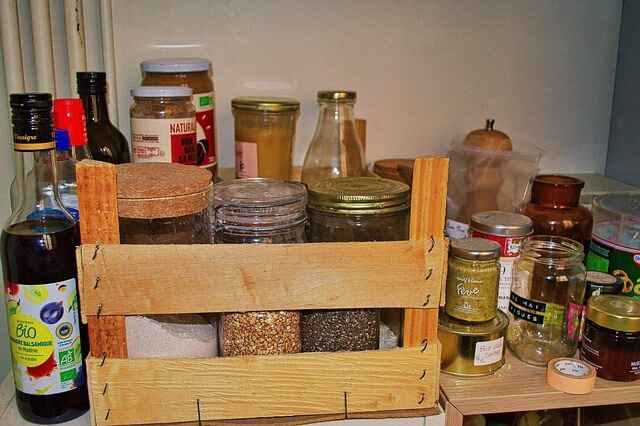A well-organized kitchen pantry can be a game-changer for your culinary experience. It not only helps you locate ingredients and cooking essentials quickly but also reduces food waste and contributes to a more enjoyable cooking process. If you’ve ever struggled with a cluttered and disorganized pantry, you know the frustration it can bring. In this comprehensive guide, we will explore ten essential tips and tricks to clean and organize your kitchen pantry, transforming it into an efficient and serene space.
The Importance of a Well-Organized Pantry
Before we delve into the practical steps, let’s discuss why a well-organized pantry is essential:
- Time-Saving: An organized pantry saves you time by making it easy to find ingredients quickly during meal preparation.
- Minimizes Food Waste: When you can see what you have, you’re less likely to forget about items, leading to less food waste.
- Cost-Efficient: You’re less likely to overbuy or forget about items, saving money on groceries.
- Healthier Eating: An organized pantry encourages healthier eating by making nutritious ingredients more accessible.
- Reduced Stress: An orderly pantry can reduce stress by eliminating the frustration of searching for items.
1. Clear the Clutter
The journey to an organized pantry begins with decluttering. It’s time to say goodbye to expired items, unused ingredients, and half-empty bags of stale snacks. Follow these steps to clear the clutter:
- Check for Expiry Dates: Start by inspecting all the items in your pantry. Discard anything that is past its expiry date.
- Assess Freshness: Check for signs of spoilage, such as unusual odors, pests, or mold. Dispose of any compromised items.
- Donate or Give Away: Consider donating unopened, non-perishable items you won’t use to a local food bank or give them to friends or family.
- Toss Stale Items: If you have opened bags of chips, cereals, or other snacks that have gone stale, it’s best to discard them.
2. Assess Your Space
Before you dive into organizing, take a good look at your pantry’s layout and shelving. Understanding the available space and the types of shelves or storage options you have will help you plan your organization strategy more effectively. Here’s how to assess your pantry:
- Measure Your Space: Measure the dimensions of your pantry, including the height, width, and depth. This will help you determine the storage solutions that will fit.
- Evaluate Shelf Heights: Note the distance between shelves and the height of each shelf. This will guide you in arranging items effectively.
- Identify Dead Space: Determine if there is any unused or awkwardly shaped space in your pantry that you can utilize for storage.
- Consider Accessibility: Pay attention to how easily you can reach different parts of the pantry. This will help you decide what items should be placed where for convenience.
3. Categorize and Group Items
To create a pantry that’s easy to navigate, categorize your items. Grouping similar items together, such as canned goods, baking supplies, snacks, and spices, will make it much simpler to find what you need when cooking or baking. Here’s how to effectively categorize and group items:
- Take Inventory: Make a list of all the items in your pantry. This will help you determine how many categories you need.
- Group by Type: Start by creating broad categories such as grains, canned goods, baking supplies, snacks, and condiments.
- Sub-Categorize: Within these broad categories, further divide items into subcategories. For example, in the “spices” category, create subcategories for herbs, spices, and spice blends.
- Plan for High-Use Items: Keep frequently used items within easy reach for quick access.
4. Invest in Storage Solutions
Investing in the right storage solutions is crucial for making the most of your pantry space. Consider these options to help you stay organized:
- Clear Containers: Clear airtight containers are ideal for storing dry goods like pasta, rice, and cereal. They keep food fresh and make it easy to see when you’re running low.
- Wire Baskets: Wire baskets are perfect for items like potatoes, onions, and snacks. They provide good ventilation and are aesthetically pleasing.
- Pull-Out Drawers: Install pull-out drawers to access items at the back of deep shelves easily.
- Shelving Units: Consider adjustable shelving units that can be customized to fit your pantry’s dimensions.
- Spice Racks: Spice racks or tiered shelves can help you organize and easily access your collection of spices.
5. Label Everything
Labels are your best friends when it comes to maintaining an organized pantry. Clearly label containers, jars, and baskets to ensure that every item has its designated spot. This not only looks neat but also helps you quickly locate ingredients. Here’s how to label effectively:
- Use Uniform Labels: Create uniform labels for a consistent and organized look. You can use a label maker, printable labels, or even handwrite labels neatly.
- Include Expiry Dates: For items that don’t have an obvious expiry date, like spices, include the date of purchase on the label.
- Label Shelves: Consider labeling the shelves themselves to indicate which categories or items belong where.
6. Utilize Vertical Space
Make the most of your pantry’s vertical space by installing additional shelving or utilizing the back of the door with an organizer. These small changes can greatly increase storage capacity. Here’s how to maximize vertical space:
- Install Adjustable Shelves: If your pantry doesn’t have adjustable shelving, consider installing them. This allows you to change the height of the shelves as needed.
- Door Organizers: Over-the-door organizers with pockets or baskets are perfect for storing small items like spices, condiments, or snacks.
- Hooks and Hangers: Use hooks and hangers on the inside of the pantry door to hang items like aprons, kitchen towels, or utensils.
- Stacking Solutions: Utilize stackable storage containers or bins to make the most of the vertical space.
7. Regularly Rotate Stock
To avoid having items expire or go to waste, practice a “first in, first out” system. Put newly purchased items at the back of the shelves and move older items to the front. This way, you’ll use items before they go bad. Here’s how to implement a rotation system:
- Mark Expiry Dates: Clearly mark expiry dates on items with a label or sticker, especially if it’s not easily visible.
- Use FIFO Shelves: Designate a “first in, first out” shelf or area where you place new items. Make it a habit to check this area regularly.
- Check Your Inventory: Periodically review your pantry inventory to ensure you’re using items before they expire.
8. Keep It Clean
A clean pantry is not just about aesthetics; it’s crucial for food safety and hygiene. Regularly clean your pantry to prevent the buildup of dust, crumbs, and spills. Here’s how to keep your pantry clean:
- Schedule Cleaning Days: Set a schedule for cleaning your pantry. This can be a monthly or quarterly task, depending on your pantry’s usage.
- Remove Everything: To deep clean, remove all items from your pantry. This allows you to clean the shelves thoroughly.
- Wipe Down Shelves: Use a damp cloth or cleaning solution to wipe down shelves, making sure to get into corners and crevices.
- Vacuum or Sweep: Vacuum or sweep the pantry floor to remove crumbs and dust.
- Inspect for Pests: While cleaning, check for any signs of pests and take appropriate measures if you find any.
9. Plan and Inventory
Creating a pantry inventory list is a valuable tool for maintaining organization and reducing food waste. Here’s how to create and use a pantry inventory:
- Start an Inventory Spreadsheet: Create a digital or physical spreadsheet to list all items in your pantry.
- Record Quantity: Include the quantity of each item in your inventory.
- Update Regularly: Make it a habit to update your inventory after grocery shopping or when you use items from the pantry.
- Meal Planning: Use your inventory list when planning meals and grocery shopping. This will help you avoid buying items you already have.
10. Maintenance and Routine Check-Ups
Maintaining an organized pantry is an ongoing process. Set a routine for checking and maintaining your pantry’s organization. Here’s how to maintain your organized pantry:
- Monthly Check-Up: Perform a quick monthly check-up to ensure items are in their designated spots.
- Adjust as Needed: If you notice that certain items are frequently misplaced, consider adjusting your organization system.
- Seasonal Cleaning: Seasonal deep cleaning can help keep your pantry in top shape.
- Engage the Family: Teach family members the organization system so that everyone can contribute to maintaining it.
Conclusion
Your kitchen pantry is an essential part of your home, and a well-organized pantry can streamline your cooking routine, save you time, and reduce food waste. By implementing these ten tips and tricks, you’ll not only enjoy a tidier pantry but also a more efficient and enjoyable cooking experience.
In conclusion, organizing your kitchen pantry is a worthwhile endeavor that can make a significant difference in your daily life. So, roll up your sleeves, clear the clutter, categorize, invest in storage solutions, label everything, and make the most of your pantry’s space. With regular maintenance and routine check-ups, your kitchen pantry will become a well-organized oasis that simplifies meal preparation and adds a touch of serenity to your culinary adventures. Happy organizing!














